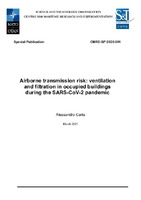Airborne transmission risk: ventilation and filtration in occupied buildings during the SARS-CoV-2 pandemic
| dc.contributor.author | Carta, Alessandro | |
| dc.date.accessioned | 2021-03-12T14:13:35Z | |
| dc.date.available | 2021-03-12T14:13:35Z | |
| dc.date.issued | 2021-03 | |
| dc.identifier.govdoc | CMRE-SP-2020-001 | en_US |
| dc.identifier.uri | http://hdl.handle.net/20.500.12489/892 | |
| dc.description.abstract | During the SARS-CoV-2 pandemic, many mitigation strategies have been employed to reduce the risk of transmission between individuals, including hygienic practices such as washing hands and objects frequently, wearing face masks, maintaining social distance between people, reducing room occupancy and tracking the health status of individuals. This document examines mitigation strategies related to airborne transmission of the SARS-CoV-2 virus inside occupied buildings. Topics covered include the impact of air conditioning and ventilation systems on the potential spread of SARS-CoV-2, recommendations for best practices, and the effectiveness of filtration on mitigating the risk of contagion. | en_US |
| dc.language.iso | en | en_US |
| dc.publisher | CMRE | en_US |
| dc.relation.ispartofseries | CMRE Special Publication Series;CMRE-SP-2020-001 | |
| dc.subject | COVID-19 | en_US |
| dc.subject | Ventilation | en_US |
| dc.subject | Air - Purification | en_US |
| dc.subject | Occupational Health | en_US |
| dc.subject | Risk Assessment | en_US |
| dc.title | Airborne transmission risk: ventilation and filtration in occupied buildings during the SARS-CoV-2 pandemic | en_US |
| dc.type | Technical Report | en_US |
